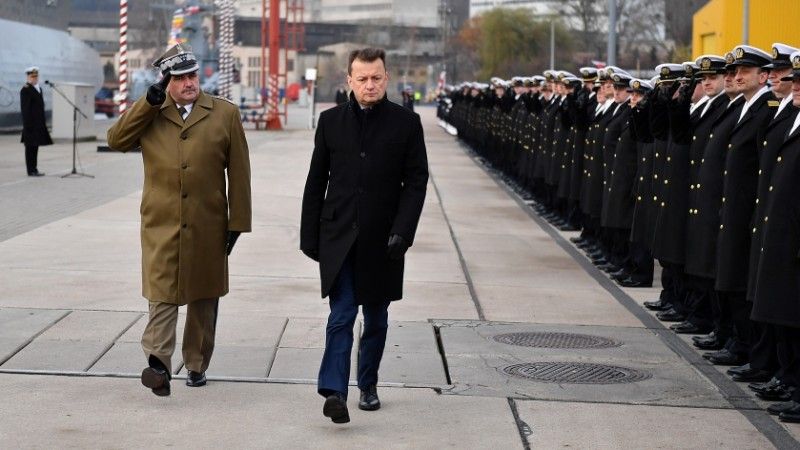Navy
"Miecznik" Programme: 1+2 Procurement Formula. Polish MoD Discusses the Frigate Project [INTERVIEW]

We assume right from the beginning that three vessels would be built, and this is the number of ships that financing is going to be provided for. This is why we would not be facing the “Gawron” project scenario, when lack of funds has made the project deformed as a whole, head of the Polish MoD, Mariusz Błaszczak told us. Błaszczak also responded reference to speculation that Narew system missiles would also be integrated on the Miecznik-class vessels.
Jędrzej Graf: What formula of proceedings has been adopted by the MoD, when it comes to the “Miecznik” class coastal defence vessel? Does it, and if yes - to what extent, contain elements of an R&D undertaking? Has the Basic National Security Interest Assessment been used, when the deal was granted? Has the order been sent directly to a specific shipyard, or have different domestic companies been approved to place their offers?
Mariusz Błaszczak, head of the Polish MoD: On 15th March I have approved a submission concerning the matter of acquiring frigate-class warships for the “Miecznik” programme, to meet the needs of the Polish Navy. Public procurement concerning the acquisition of three vessels would be sent to Polish defence industry entities, while a contractor, or contractors, would accomplish the task, with support being provided by a foreign partner. We want the warships to be built at domestic shipyards - not only the ones belonging to PGZ, but also the private ones. Similar cooperation between privately-owned shipyards and the PGZ Group turned out to be a success, during the minehunters programme.
Obviously, the frigate is a much bigger challenge, that also comes with respectively greater requirements. However, I do believe that our industry is capable of developing a cooperation scheme that would satisfy all parties involved. This project is a huge opportunity that the Polish industry is facing as a whole, as the ability to build, maintain and modernize warships would allow us to join the global leaders in this domain.
Does the procedure that is going on pertain to the acquisition of three vessels within a single acquisition (without an option), or has it been divided into the primary agreement and the right of option?
The conditions for the acquisition would be defined as a result of a procedure carried out, concerning the awarding of the public procurement. I expect a “1+2” order, similarly as in the case of the Mine Countermeasures Vessels. The prototype vessel makes it possible to find and rectify the infancy period problems when manufacturing the remaining two, series manufactured vessels. Here one should unambiguously stress that we assume right from the beginning that three vessels would be built, and this is the number of ships that financing is going to be provided for
This is why we would not be facing the “Gawron” project scenario when lack of funds has made the project deformed as a whole. The main task is to create a vessel for the Polish Navy that would be able to face the current and future requirements of the modern battlefield. Miecznik-class vessels would amplify the capabilities of the Navy, for instance, thanks to their multi-role capabilities, universal character, and great firepower.
Numerous foreign shipbuilding companies exist on the market, offering frigates, as well as there are many businesses manufacturing specialist equipment and armament that is not available in Poland as of today. Significant foreign competition makes a broad transfer of technology available to the Polish shipyards and allows us to negotiate a competitive deal. In what way the foreign businesses would be compared? Who would be the entity to make the assessment - the Polish Ministry of Defence, or the PGZ Group? When will the foreign companies be able to make offers?
The vessels planned to be procured would expand the capabilities of the Polish Navy, within the scope of conducting surveillance and control over the bodies of water, port protection, acting against surface targets, submarines and land threats in the coastal area, as well as conducting naval air defence. Thus, the vessels would be equipped with air/missile defence systems, water-to-water, and water-to-ground effectors, and torpedoes for ASW. Each of the “Miecznik” vessels would offer firepower comparable to the Naval Missile Unit [MJR]. Now, within the framework of the procurement process, we are to find a bidder who would be able to meet all of those expectations, also complying with the assumed budget and timeline.
The procedures aimed at procurement of equipment and armament to fulfill the requirements of the Armed Forces are described in detail, and they would also apply to this process. The Polish Navy’s sailors have defined their requirements, unanimously stating that frigates would be the best choice, and now we would be waiting for proposals of the Polish industry supported by the experience of a foreign partner who would be willing to share the “know-how”. I would also like to add in the fact that implementation of the “Miecznik” programme in that form is aligned with the Strategic Concept of Maritime Security for the Republic of Poland, drafted in line with the order made by the President, Andrzej Duda. I hope that agreement would be signed before the half of this year. I want to stress that I will be supervising the whole process myself. I will not allow for overpricing, I will also not allow for complications stemming from artificial changes to the requirements, or from excessively pushing them and expanding when it comes to the new vessel.
What is the role that would be assigned to the foreign partner, during the proceedings - would it act as a consortium member, or as a sub-contractor for the Polish companies?
The foreign partner would be supporting the implementation of the project as a whole. The Ministry of Defence would assess the possible solutions proposed by the contractors, while the role and scope of cooperation with the potential foreign partner would be further specified within the framework of the ongoing procedure. The order would be awarded to the Polish defence industry, which would lead to the recovery of the shipbuilding potential at the Polish shipyards so that they would be able to deliver warships for the Polish Navy.
The transfer of technology and know-how required to build and equip the vessels will allow the Polish entities to take responsibility for the whole lifecycle of the warship. This is a major investment that creates an entirely new set of possibilities. We need to think about this project on a timeline involving the upcoming decades, not months. Not only is a short-term capacity of building a functioning vessel at stake here, as long term maintenance, servicing, repairs, and ultimately - upgrades, also are.
How would you refer to the media reports suggesting that the foreign partner, in the Miecznik programme, has already been selected, behind the scenes?
As I already said, we will be only starting to assess the possible solution variants, including ones pertaining to the selection of the foreign partner. The procurement procedures in force, in the Polish military, precisely define how this process should look. We will be following the matters related to the scope of the transfer of technology, to expand the capacity of the Polish shipyards to the greatest possible extent. We have all got used to the fact that any large contract creates media speculation.
Is the configuration of the warship, its armament, and equipment, such as specific radars or sonar systems, known already? And would the shipbuilding agreement also include integration with all elements contained in configuration, tailoring it to use specific types of armament included, or would those elements be subjected to a separate contract?
The complementary nature of the systems and flawless integration is the top priority, from the point of view of the user, the Navy. Building a ship can be compared to building a large aircraft. Its components could come from different manufacturers, however, the final integration takes place at a single facility. Here, it’s all going to be identical. Even if the individual components, armament, or software are delivered by other suppliers, the responsibility for connecting them into a single, coherently functioning single organism would be placed in the hands of the Polish shipbuilding industry.
You have said that a particular emphasis would be placed, on one hand, not to overpay, and experience excessive cost, on the other, not to create too high requirements that could consequently lead to delays and higher program expenses. You have said that by mid-2021 an agreement would be signed - is this enough time to prepare and negotiate proper conditions?
The acquisition of three vessels for the Polish Navy, within the Miecznik programme, is a priority goal for the Polish MoD, and we are counting on the task being accomplished as fast as possible. Equally important is for the agreement that we want to conclude over the upcoming months to be both ready and properly prepared, from the legal and formal perspective, and from the point of view of benefit it would create for the Polish Armed Forces, also being a chance to develop the Polish shipbuilding industry.
There has been enough time to define the requirements, given to the Navy. Now we want to inhibit the changes that are not necessary from the point of view of combat value the vessel may have, and that could have influence over the project-related delays. I will also be paying close attention to the entities participating in the programme, within the scope of quoting of the individual services, and extra cost that could emerge at further stages of project implementation. These have been the two main causes for the Gawron programme to fail. This time, we will be realistically assessing all aspects of the programme aimed at building new warships, as we cannot afford any further delays.
Could you refer to the speculation that Miecznik may be equipped with SHORAD missiles similar (or identical) to the ones planned to be acquired in the Narew system?
The definition of the final configuration and equipment for the Miecznik-programme vessels would take place over the course of the procurement procedure that is being carried out. Each armament type has its purpose. The warship will be the platform here - this gives us a lot of options, but also imposes a lot of limitations stemming from the operating environment. I believe that fusing the capacity of our industry and human resources will allow us to rationally select the applied weapons systems. The Polish Navy operates numerous types of armament, and introduction of new armament types always entails a necessity of creating a system for the supply chain, storage, maintenance, or overhauls.
When can we expect the warships to be delivered?
I assume that the shipbuilding process will go along smoothly and in a speedy manner. The delivery deadlines have been set out in the 2021-2035 Technical Modernization Plan, Taking into the Account the Year 2020. Detailed delivery timeline and costs of acquiring the warships for the Polish Navy would be defined over the course of negotiation with the contractor.
Thank you for the conversation.
